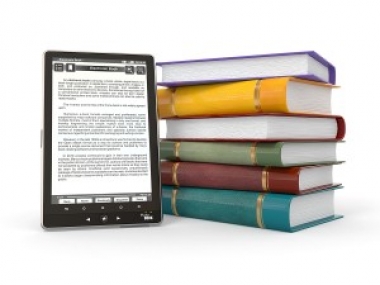Books or E-readers? Which are better for your eyes?

If you liked to read books when you were growing up, you probably heard the same warning from your parents that we all did – stop reading in low light or you’ll damage your eyes and wind up wearing glasses. While there are fates worse than glasses, the message is clear – You should protect your eyes, because eyesight is the most important sense we have.
Fast-forward to today, and we’ve begun to hear similar warnings, but not about paper books this time. No, now the culprits are E-readers, the electronic devices that more and more people are using to flip though their favourite novels. With the popularity of E-readers, and the pushback from traditional book lovers, we thought we would weigh in and decide which is better for your eyesight, and maybe debunk a few myths along the way.
 First, let’s take a look at the warning from your mother about reading in the dark. Will it ruin your eyesight? Well, No, it turns out you aren’t going to damage your eyesight reading in low light, but it can cause some serious eyestrain and you may end up with a headache. So that’s a point for books!
First, let’s take a look at the warning from your mother about reading in the dark. Will it ruin your eyesight? Well, No, it turns out you aren’t going to damage your eyesight reading in low light, but it can cause some serious eyestrain and you may end up with a headache. So that’s a point for books!
Well, it seems that the same warning about reading from screens is also overblown. While normal TV and computer screens can also cause eyestrain if stared at for too long, most E-readers use more eye friendly technology to produce their images. There is the black and white E Ink technology found in the Kindle, as well as the full colour IPS LCD that comes in the Apple IPad. Both of these technologies offer an impressive reading experience for users, although E Ink struggles in lower light, and LCD users may experience reflection issues in brightly lit situations.

But are they better or worse for your eyes than traditional paper books? The answer is ……
There really isn’t that much difference in terms of eyesight health!
The new screens that are being used on E-readers are so improved from earlier versions that our eyes can’t detect their movements. So the real issue is the same as reading a paper book. Reading, whether on paper or screen, is a hugely demanding task for your eyes, and in either case you should be taking a break every 20 minutes. Give your eyes a chance to rest, and you’ll reduce eye strain and avoid headaches and muscle aches that can keep you from your latest bestseller.
In the end the choice of reading device is up to each individual. Some people like the convenience of carrying multiple books around in a small lightweight device, while others love the feel and smell of a good paperback.
It really just depends on which medium you are most comfortable with!





 First, let’s take a look at the warning from your mother about reading in the dark. Will it ruin your eyesight? Well, No, it turns out you aren’t going to damage your eyesight reading in low light, but it can cause some serious eyestrain and you may end up with a headache. So that’s a point for books!
First, let’s take a look at the warning from your mother about reading in the dark. Will it ruin your eyesight? Well, No, it turns out you aren’t going to damage your eyesight reading in low light, but it can cause some serious eyestrain and you may end up with a headache. So that’s a point for books!

